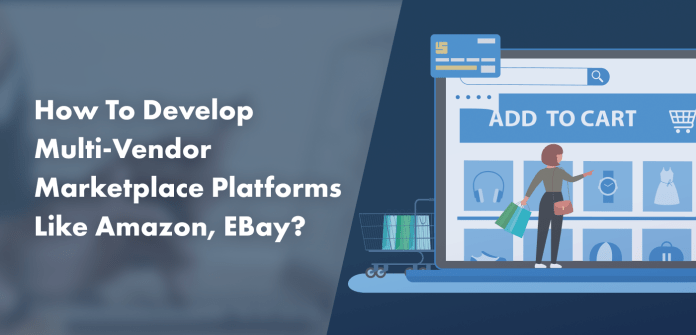E-commerce has completely changed how people purchase and do business in the current digital era. Marketplaces with many vendors, such as those on Amazon and eBay, have become industry leaders by providing a wide variety of goods and services from multiple vendors to a large global audience.
If you want to build your own successful online marketplace, this in-depth article will explain what is the multi-vendor marketplace and how to develop it.
What is Multi-Vendor Marketplace Platform?
An online marketplace that allows several independent vendors or sellers to promote and offer their goods or services to a variety of customers is known as a multi-vendor marketplace platform.
In this type of online marketplace, the platform owner acts as an intermediary, facilitating transactions between buyers and sellers while earning a commission or fees on each transaction. The concept of a multi-vendor marketplace is quite different from a traditional e-commerce store where a single business sells its products directly to customers.
Top 7 Steps to Develop a Multi-Vendor eCommerce Marketplace Platform
- Market Research and Planning
- Choose the Right Technology Stack
- Define Business Model
- Platform Architecture
- Performance Optimization & Testing
- Launch and Marketing
- Feedback and Continuous Improvement
Market Research and Planning
Every successful venture begins with thorough market research and strategic planning. Identify your target market, study consumer behavior, and recognize potential competitors. Understanding your niche will help you refine your business model, revenue streams, and unique value proposition.
Choose the Right Technology Stack
Selecting the appropriate technology stack is crucial to develop a multi-vendor marketplace platform. Popular backend frameworks like Laravel, Ruby on Rails, Django, or Node.js, coupled with frontend JavaScript frameworks like React, Angular, or Vue.js, provide the necessary basis for creating a dynamic and user-friendly marketplace.
Define Business Model
Decide on the revenue model (e.g., commissions, subscription fees, listing fees, etc.). Define the terms and conditions for vendors, such as payment processing and shipping policies. Plan how you’ll attract sellers and buyers to your platform.
Platform Architecture
Define the architecture of your multi-vendor platform, including the database schema, user authentication, and authorization mechanisms. Create a seamless flow of data between users and the system to ensure smooth interactions and transactions.
Performance Optimization and Testing
Optimize your platform for speed and responsiveness to provide a seamless user experience. Conduct regular performance testing and optimizations to ensure smooth operations.
Rigorously test your platform to identify and fix any bugs or issues. Conduct security testing and stress testing to ensure the platform can handle high traffic loads without compromising performance.
Launch and Marketing
Once you have thoroughly tested your platform, deploy it to a production environment. Develop a comprehensive marketing strategy to attract both buyers and sellers to your marketplace, leveraging various digital marketing channels.
Feedback and Continuous Improvement
Gather feedback from users to understand their pain points and requirements. Continuously iterate on your platform, introducing new features and improvements to enhance user experience and stay competitive in the market.
Must-Have Features to Develop a Multi-Vendor e-Commerce Marketplace
- User Registration and Authentication
- Vendor Onboarding
- Product Listing and Management
- Search and Filtering
- Shopping Cart and Checkout
- Order Management and Processing
- Ratings and Reviews
User Registration and Authentication
Implement a secure and user-friendly registration and login system for both buyers and sellers. Enhance security with features like two-factor authentication and integrate social media logins to streamline the onboarding process.
Vendor Onboarding
Allow vendors to register and create their profiles with ease. Develop a verification process to verify vendor identities and ensure the authenticity of the sellers on your platform, building trust among buyers.
Product Listing and Management
Enable vendors to add, edit, and manage their products through an intuitive interface. Include features such as product categories, tags, and attributes to improve searchability and enhance the overall user experience.
Search and Filtering
Develop a powerful search functionality to help buyers find products quickly. Implement filters based on categories, price ranges, locations, and other relevant attributes, enabling users to refine their search results effectively.
Shopping Cart and Checkout
Create a seamless shopping cart experience for buyers, allowing them to add multiple products from different vendors and proceed to checkout effortlessly. Integrate with secure payment gateways to facilitate smooth and safe transactions.
Order Management and Processing
Implement an efficient order tracking system that keeps both buyers and sellers informed about their orders’ status. Set up automated order processing and notifications to streamline the fulfillment process.
Ratings and Reviews
Encourage buyers to leave honest ratings and reviews for products and vendors. Implement a robust moderation system to handle inappropriate content and maintain the integrity of your marketplace.
Ready to take the next step? Get in touch with experts to make informed decisions to create a multi-vendor e-commerce marketplace platform!
Conclusion
Building a multi-vendor online marketplace platform like Amazon and eBay is a challenging yet rewarding endeavor. By following this comprehensive guide and leveraging the right technology, you can create a successful marketplace that connects buyers and sellers globally, fostering a thriving ecosystem of commerce and growth.
Remember that continuous improvement, a user-centric approach, and adapting to market demands will be critical to your platform’s long-term success.
